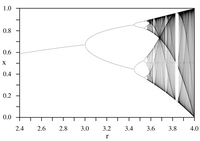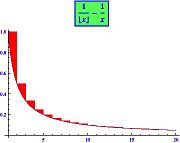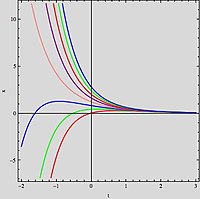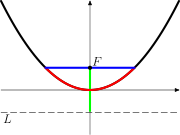Talk:Constant/Old history: Difference between revisions
Randomblue (talk | contribs) |
Gracenotes (talk | contribs) |
||
| Line 40: | Line 40: | ||
Despite being a special value of the [[Riemann zeta function]], [[Apéry's constant]] arises naturally in a number of physical problems, including in the second- and third-order terms of the [[electron]]'s [[gyromagnetic ratio]], computed using [[quantum electrodynamics]]<ref>{{cite web|url=http://mathworld.wolfram.com/AperysConstant.html|title=Apéry's constant|first=Steven|last=Finch|accessdate=08-12-2007}}</ref>. Also, [[Pascal Wallish]] noted that <math>\sqrt{m_n/m_e}\approxeq\frac{3}{\sqrt{\varphi}-\zeta(3)}</math><ref>http://www.eaglemanfoundation.org/</ref>, where <math>m_n,m_e,\varphi</math> are the [[neutron]] mass, the [[electron]] mass and the [[Golden ratio]] respectively. |
Despite being a special value of the [[Riemann zeta function]], [[Apéry's constant]] arises naturally in a number of physical problems, including in the second- and third-order terms of the [[electron]]'s [[gyromagnetic ratio]], computed using [[quantum electrodynamics]]<ref>{{cite web|url=http://mathworld.wolfram.com/AperysConstant.html|title=Apéry's constant|first=Steven|last=Finch|accessdate=08-12-2007}}</ref>. Also, [[Pascal Wallish]] noted that <math>\sqrt{m_n/m_e}\approxeq\frac{3}{\sqrt{\varphi}-\zeta(3)}</math><ref>http://www.eaglemanfoundation.org/</ref>, where <math>m_n,m_e,\varphi</math> are the [[neutron]] mass, the [[electron]] mass and the [[Golden ratio]] respectively. |
||
==== The Golden ratio |
==== The Golden ratio φ ==== |
||
[[Image:Icosahedron-golden-rectangles.svg|thumb|right|Golden rectangles in an icosahedron]] |
[[Image:Icosahedron-golden-rectangles.svg|thumb|right|Golden rectangles in an icosahedron]] |
||
Revision as of 00:12, 9 December 2007
Constants are numbers or values, recurring and fundamental in both mathematics and science. They may represent universal facts -also called invariants-, simplify notation, link physical quantities within physical theories, check the overall consistency of physical models, or simply be ubiquitous. Constants are very versatile entities as they may be exact or approximate and experimentally determined, dimensionless or dimensionful with appropriate units of measurement applied, and even unspecified, when occurring for example in integrals.
When dealing with dimensionfull constants, a set of units must be chosen. Sometimes, one unit is defined in terms of another unit. For example, the metre is defined as 1⁄299 792 458 of a light-second. This definition implies that, in metric units, the speed of light in vacuum is exactly 299,792,458 metres per second.[1]. No increase in the precision of the measurement of the speed of light could alter this numerical value of expressed in metres per second.
One always talks about definable, and almost always also, computable mathematical constants. However, there are still some constants -mathematical or not-, like Landau's constants[2], Erdos' reciprocal sum constants[3] or the Fermi coupling constant for which only very rough estimates are known.
As noted by Steven Finch, "All numbers are not created equal." [4] We shall therefore make the following classification: 'super-universal' constants, universal constants, locally interesting constants, plain numbers or facts and unspecified constants.
'Super-universal' constants - occurring in both mathematics and physics
Ubiquitous in many different fields of science, such recurring constants include π, e and the Feigenbaum constants which are linked to the mathematical models used to describe physical phenomena, Euclidian geometry, analysis and logistic maps respectively. However, mathematical constants such as Apéry's constant and the Golden ratio occur unexpectedly outside of mathematics.
Archimedes' constant

Pi, though having a natural definition in Euclidian geometry (the circumference of a circle of diameter 1), may be found in many different places in mathematics. Key examples include the Gaussian integral in complex analysis, nth roots of unity in number theory and Cauchy distributions in probability. However, its universality is not limited to mathematics. Indeed, various formulas in physics, such as Heisenberg's uncertainty principle bear the constant pi. The presence of pi in physical principles, laws and formulas can have very simple explanations. For example, Coulomb's law, describing the inverse square proportionality of the magnitude of the electrostatic force between two electric charges and their distance, states that, in SI units, [5]. Here, is just the surface area of a sphere of radius [6][7].
The exponential growth - or Napier's - constant


The exponential growth constant appears in many parts of applied mathematics. For example, as the Swiss mathematician Jacob Bernoulli discovered, e arises in compound interest. Indeed, an account that starts at $1, and yields dollars at simple interest, will yield dollars with continuous compounding. also has applications to probability theory, where it arises in a way not obviously related to exponential growth. Suppose that a gambler plays a slot machine with a one in n probability and plays it n times. Then, for large n (such as a million) the probability that the gambler will win nothing at all is (approximately) . Another application of e, also discovered in part by Jacob Bernoulli along with French mathematician Pierre Raymond de Montmort is in the problem of derangements, also known as the hat check problem[8]. Here n guests are invited to a party, and at the door each guest checks his hat with the butler who then places them into labelled boxes. But the butler does not know the name of the guests, and so must put them into boxes selected at random. The problem of de Montmort is: what is the probability that none of the hats gets put into the right box. The answer is and as the number of guests tends to infinity, approaches .
The Feigenbaum constants and

Iterations of continuous maps serve as the simplest examples of models for dynamical systems.[9] The two Feigenbaum constants appear in such iterative processes: they are mathematical invariants of logistic maps with quadratic maximum points[10] and their bifurcation diagrams.
The logistic map is a polynomial mapping, often cited as an archetypal example of how chaotic behaviour can arise from very simple non-linear dynamical equations. The map was popularized in a seminal 1976 paper by the biologist Robert May[11], in part as a discrete-time demographic model analogous to the logistic equation first created by Pierre François Verhulst. The difference equation is intended to capture the two effects or reproduction and starvation.
Apéry's constant
Despite being a special value of the Riemann zeta function, Apéry's constant arises naturally in a number of physical problems, including in the second- and third-order terms of the electron's gyromagnetic ratio, computed using quantum electrodynamics[12]. Also, Pascal Wallish noted that [13], where are the neutron mass, the electron mass and the Golden ratio respectively.
The Golden ratio φ

The number turns up frequently in geometry, particularly in figures with pentagonal symmetry. Indeed, the length of a regular pentagon's diagonal is times its side. The vertices of a regular icosahedron are those of three mutually orthogonal golden rectangles. Also, it appears in the Fibonacci sequence, related to growth by recursion[14].
Adolf Zeising, whose main interests were mathematics and philosophy, found the golden ratio expressed in the arrangement of branches along the stems of plants and of veins in leaves. He extended his research to the skeletons of animals and the branchings of their veins and nerves, to the proportions of chemical compounds and the geometry of crystals, even to the use of proportion in artistic endeavors. In these phenomena he saw the golden ratio operating as a universal law.[15] Zeising wrote in 1854:
[The Golden Ratio is a universal law] in which is contained the ground-principle of all formative striving for beauty and completeness in the realms of both nature and art, and which permeates, as a paramount spiritual ideal, all structures, forms and proportions, whether cosmic or individual, organic or inorganic, acoustic or optical; which finds its fullest realization, however, in the human form.[16]
Universal constants - occuring in general mathematical settings or physical phenomena
In mathematics, these constants are invariants of wide classes of objects. For example, is the invariant ratio of any circle's circumference to its diameter[17]. It is in specific mathematical settings that such natural definitions arise. For example, Catalan's constant in combinatorics, Euler-Mascheroni constant in analysis, etc. In physics, universal constants appear in the basic theoretical equations upon which the entire science rests or are the properties of the fundamental particles of physics of which all matter is constituted (the electron charge , the electron mass and the fine-structure constant ).
The Euler-Mascheroni constant

The Euler-Mascheroni constant is a recurring constant in number theory. The French mathematician De la Vallée Poussin proved in 1898 that when taking any positive integer n and dividing it by each positive integer m less than n, the average fraction by which the quotient n/m falls short of the next integer tends to as n tends to infinity. Surprizingly, this average doesn't tend to one half[18]. The Euler-Mascheroni constant also appears in Merten's third theorem and has relations to the gamma function, the zeta function and many different integrals and series. The definition of the Euler-Mascheroni constant exhibits a close link between the discrete and the continuous (see curves on the right).
The magnetic flux quantum
It is a property of a supercurrent (superconducting electrical current) that the magnetic flux passing through any area bounded by such a current is quantized. The magnetic flux quantum is a physical constant, as it is independent of the underlying material as long as it is a superconductor.
Conway's constant
Conway's constant is the invariant growth rate of all derived strings similar to the look-and-say sequence (except two trivial ones)[19]. It is given by the unique positive real root of a polynomial of degree 71 with integer coefficients[20].
Khinchin's constant
If a real number is written using simple continued fraction , then, as Russian mathematician Khinchin proved in 1934, the limit as tends to infinity of the geometric mean exists, and, except for a set of measure 0, this limit is a constant, Khinchin's constant[21][22].
The speed of light and Planck's contant
The velocity of light and Planck's constant are examples of quantities that occur naturally in the mathematical formulation of certain fundamental physical theories, the former in James Clerk Maxwell's theory of electric and magnetic fields and Albert Einstein's theories of relativity, and the latter in quantum theory. For example, in special relativity, mass and energy are equivalent: [23] where is the constant of proportionality. In quantum mechanics, the energy and frequency of a photon are related by .
The speed of light is also used to express other fundamental constants [24] such as the electric constant , Coulomb's constant and the characteristic impedance of vacuum .
Plain numbers, mathematical curiosities and specific physical facts
Constants representing physical properties of elements
Such constants represents characteristics of certain physical objects such as the chemical elements. Examples include density, melting point and heat of fusion. Some of the properties of gold are listed in the box on the right.
Plain numbers: general -and usually uninteresting- constants
In mathematics, all numbers -natural, integer, real, complex, etc.- are technically speaking constants in mathematics, and play a fundamental role in algebraic manipulations. Like every mathematical object, constants should be defined rigorously. As suggested above, the notion of a constant in mathematics depends crucially on that of a number. The most basic natural numbers are defined using set theory and a precise set of axioms[25]. After that, the integers are the integers with their negatives, the rational numbers are quotients of integers: . Similarly, the reals can be constructed from the rational numbers and the complex numbers from the real numbers . This hierarchy is represented by the string of inclusions .
Mathematical curiosities: constants with interesting properties

Some constants, such as the square root of two, Liouville's constant and Champernowne constant are not important mathematical invariants, but still of interest since they are simple representatives of special sets of numbers, the irrational numbers, the transcendental numbers[27] and the normal numbers (in base 10)[28] respectively. The square root of two and Liousville's constant were the first numbers of their kind to be explicitly constructed.
Unspecified constants
When unspecified, constants indicate classes of similar objects, commonly functions, all equal up to a constant.
The constant term of a function is an addend that doesn't vary. Similarly, a constant coefficient is a multiplying factor that doesn't vary. For example, when writing where are constant, is the (unspecified) constant coefficient and is an unspecified constant term. Such unspecified constants appear frequently when dealing with integrals and differential equations. Though these constant are unspecified, they are constant and hence have a specific value, which often isn't important. Technically speaking, unspecified constants appear when dealing with similarity up to a constant.
In integrals
Indefinite integrals are called indefinite because their solutions are only unique up to a constant. For example, when working over the field of real numbers where , the constant of integration, is an arbitrary fixed real number[29]. In other words, whatever the value of , when differentiating with respect to , the answer is always .
In differential equations

In a similar fashion, constants appear in the solutions to differential equations where not enough initial values or boundary conditions are given. For example, the ordinary differential equation has solution where is an arbitrary constant.
When dealing with partial differential equations, the constants may be functions, constant with respect to some variables (but not necessarily all of them). For example, the PDE has solutions where is an arbitrary function in the variable .
Notation
Representing constants
Different symbols are used to represent and manipulate constants, such as , and . It is common, in both mathematics and physics, to express the numerical value of a constant by giving its decimal expansion. For two reasons this representation may cause problems. First, even though rational numbers all have a finite or ever-repeating decimal expansion, some numbers don't have such an expression and it would hence be impossible to completely give its value using this method. Also, the decimal expansion of a number is not necessarily unique. For example, the numbers 0.999... and 1 are equivalent[30], that is they represent the same constant.
It happens that some constants differ so much from the usual kind that a special notation must be invented to represent them. Graham's number is such an example when the Knuth up-arrow notation is used.[31][32]
Commonly, constants in the physical sciences are represented using the scientific notation, with, when appropriate, the inaccuracy - or measurement error - attached. When writing Planck's constant [33] it is meant that . Only the significant figures are shown and a greater precision would be superfluous, extra figures coming from experimental inaccuracies. When writing Isaac Newton's gravitational constant [34] only 6 significant figures are given.
For mathematical constants, it may be of interest to represent them using continued fractions to perform various studies, including statistical analysis.
Symbolizing and naming of constants
Symbolizing constants with letters is a frequent means of making the notation more concise. A standard convention, instigated by Euler is the 18th century, is to use lowercase letters from the beginning of the Latin alphabet or the Greek alphabet when dealing with constants in general.
Embree-Trefethen constant
Brun's constant for twin prime
Rydberg constant
cardinal number aleph naught
However, for more important constants, the symbols may be more complex and have an extra letter, an asterisk, a number, a lemniscate or use different alphabets such as Hebrew, Cyrillic or Gothic[35].
Sometimes, the symbol representing a constant is a whole word. For example, American mathematician Edward Kasner's 9-year-old nephew coined the names googol and googolplex[36][37].

The names are either related to the meaning of the constant (characteristic impedance of vacuum, twin prime constant, electric constant, universal parabolic constant, conductance quantum, ...), to a specific person (Planck's constant, Sierpiński's constant, Dirac's constant, Josephson constant, ...) or both (Newtonian constant of gravitation, Bohr magneton, Fermi coupling constant[38],...).
Lumping constants
A common practice in physics is to lump constants, to simply the equations and algebraic manipulations. For example, Coulomb's constant [39] is just , and lumped together. Also, combining old constants does not necessarily make the new one less fundamental. For example, the -notably- dimensionless fine-structure constant is a fundamental constant of quantum electrodynamics and in the quantum theory of the interaction among electrons, muons and photons.
A notation simplifier : the Avogadro constant
The Avogadro constant is the number of entities in one mole, commonly used in chemistry, where the entities are often atoms or molecules. Its unit is inverse mole. However, the mole being a counting unit, we can consider the Avogadro constant dimensionless, and, contrary to the speed of light, the Avogadro constant doesn't convert units, but acts as a scaling factor for dealing practically with large numbers.
Mystery and aesthetics behind constants

For some authors, constants, either mathematical or physical may be mysterious, beautiful or fascinating. For example, English mathematician J. W. L. Glaisher (1915) writes [40]: "No doubt the desire to obtain the values of these quantities to a great many figures is also partly due to the fact that most of them are interesting in themselves; for , and many other numerical quantities occupy a curious, and some of them almost a mysterious, place in mathematics, so that there is a natural tendency to do all that can be done towards their precise determination".
Srinivasa Ramanujan discovered the following mysterious identity containing pi and Pythogoras' constant :.
Steven Finch writes that "The fact that certain constants appear at all and then echo throughout mathematics, in seemingly independent ways, is a source of fascination."[41]
During the 1920s until his death, Arthur Stanley Eddington increasingly concentrated on what he called "fundamental theory" which was intended to be a unification of quantum theory, relativity and gravitation. At first he progressed along "traditional" lines, but turned increasingly to an almost numerological analysis of the dimensionless ratios of fundamental constants. In a similar fashion, Paul Dirac studied ratios of fundamental physical constant to build his large numbers hypothesis.
See also
| Mathematical constant Physical constant Astronomical constant |
Scalar Coefficient Number |
Constant function Constant of integration Cosmological constant |
References
- ^ CODATA. "Speed of light in vacuum". 2006 CODATA recommended values. NIST. Retrieved 2007-08-08.
- ^ Rademacher, H. "On the Bloch-Landau Constant." American Journal of Mathematics 65, 387-390, 1943
- ^ Finch, Steven (2003). Mathematical constants. Cambridge University Press. p. 163. ISBN 0-521-81805-3.
- ^ Finch, Steven (2003). Mathematical constants. Cambridge University Press. ISBN 0-521-81805-3.
- ^ Nave, C. Rod (2005-06-28). "Coulomb's Law". HyperPhysics. Georgia State University. Retrieved 2007-11-09.
{{cite web}}: Check date values in:|date=(help) - ^ "Surface Area of Spheres". Teachers' Choice Software. Retrieved 2007-11-10.
- ^ Garber, David. "A Mechanical Derivation of the Area of the Sphere" (PDF). Bar Ilan University Computer Science Department. Retrieved 2007-11-10.
{{cite journal}}: Cite journal requires|journal=(help); Unknown parameter|coauthors=ignored (|author=suggested) (help) - ^ Grinstead, C.M. and Snell, J.L. Introduction to probability theory (published online under the GFDL), p. 85.
- ^ Collet & Eckmann (1980). Iterated maps on the inerval as dynamical systems. Birkhauser. ISBN 3-7643-3026-0.
- ^ Finch, Steven (2003). Mathematical constants. Cambridge University Press. p. 67. ISBN 0-521-81805-3.
- ^ May, R.M. (ed.). 1976 (and 1981). Theoretical Ecology: Principles and Applications. Blackwell Scientific Publishers. ISBN 0-632-00768-0
- ^ Finch, Steven. "Apéry's constant". Retrieved 08-12-2007.
{{cite web}}: Check date values in:|accessdate=(help) - ^ http://www.eaglemanfoundation.org/
- ^ Livio, Mario (2002). The Golden Ratio: The Story of Phi, The World's Most Astonishing Number. New York: Broadway Books. ISBN 0-7679-0815-5.
- ^ Ibid. Padovan, R. Proportion: Science, Philosophy, Architecture , pp. 305-06
- ^ Zeising, Adolf, Neue Lehre van den Proportionen des meschlischen Körpers, Leipzig, 1854, preface.
- ^ "About Pi". Ask Dr. Math FAQ. Retrieved 2007-11-27.
- ^ Finch, Steven. "Euler-Mascheroni constant". Retrieved 2007-12-08.
- ^ Finch, Steven (2003). Mathematical constants. Cambridge University Press. p. 453. ISBN 0-521-81805-3.
- ^ Finch, Steven. "Conway's Constant". Wolfram MathWorld. Retrieved 2007-12-07.
- ^ M. Statistical Independence in Probability, Analysis and Number Theory. Mathematical Association of America. 1959.
{{cite book}}:|first=missing|last=(help) - ^ Finch, Steven. "Khinchin's Constant". Retrieved 08-12-2007.
{{cite web}}: Check date values in:|accessdate=(help) - ^ Einstein, A. (1905), "Ist die Trägheit eines Körpers von dessen Energieinhalt abhängig?", Annalen der Physik, 18: 639–643
{{citation}}: External link in|title= - ^ http://physics.nist.gov/cgi-bin/cuu/Category?view=html&Universal.x=15&Universal.y=6
- ^ Landau, Edmund (1960). Foundations of analysis. Chealsea publishing company. pp. 1–18.
- ^ Fowler and Robson, p. 368.
Photograph, illustration, and description of the root(2) tablet from the Yale Babylonian Collection
High resolution photographs, descriptions, and analysis of the root(2) tablet (YBC 7289) from the Yale Babylonian Collection - ^ Aubrey J. Kempner (Oct 1916). "On Transcendental Numbers". Transactions of the American Mathematical Society. 17 (4): 476–482.
{{cite journal}}: CS1 maint: year (link) - ^ D. G. Champernowne (1933). "The onstruction of decimals normal in the scale of ten". Journal of the London Mathematical Society. 8: 254–260.
- ^ Calculus with analytic geometry, fourth edition, Edwards & Penney, p.269
- ^ Rudin p.61, Theorem 3.26; J. Stewart p.706
- ^ Knuth, D. E. "Mathematics and Computer Science: Coping with Finiteness. Advances in Our Ability to Compute are Bringing Us Substantially Closer to Ultimate Limitations." Science 194, 1235-1242, 1976.
- ^ "mathematical constants". Retrieved 2007-11-27.
- ^ "CODATA values". Retrieved 2007-11-27.
- ^ "CODATA values". Retrieved 2007-11-27.
- ^ "mathematical constants". Retrieved 2007-11-27.
- ^ Mathematics and the Imagination. Microsoft Press. 1989. p. 23.
{{cite book}}: Unknown parameter|authors=ignored (help) - ^ "mathematical constants". Retrieved 2007-11-27.
- ^ http://physics.nist.gov/cgi-bin/cuu/Value?g
- ^ "Coulomb's constant". Retrieved 2007-11-27.
- ^ "Mathematical constants and computation". Retrieved 2007-11-27.
- ^ Finch, Steven (2003). Mathematical constants. Cambridge University Press. ISBN 0-521-81805-3.
Further reading
- Finch, Steven (2003). Mathematical Constants. Cambridge University Press. ISBN 0-521-81805-2.
- Miller, Jeff (2007). ""Earliest Uses of Symbols for Constants".
External links
zh-min-nan:Tiāⁿ-sò͘ bg:Константа da:Konstant de:Konstante et:Konstant es:Constante eo:Konstanto fr:Constante gd:Cunbhal ko:상수 id:Konstanta it:Costante lt:Konstanta nl:Constant (eigenschap) ja:定数 no:Konstant pt:Constante ru:Константа simple:Constant sr:Константа fi:Vakio sv:Konstant th:ค่าคงตัว uk:Константа zh:常数



















































































